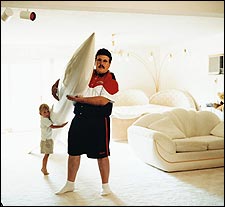KY MICHAELSON CALLS HIMSELF THE ROCKETMAN, which is a lot of nickname for a 65-year-old family guy living in Bloomington, Minnesota. But Michaelson has earned it. A former stunt coordinator for Burt Reynolds action films like Stick and Sharkey’s Machine, he’s spent the past half-century mounting rocket thrusters on motorcycles, wheelchairs, snowmobiles, bicycles, pickups, sleds, and even a toilet. Now he’s constructed the Go-Fast Rocket, which he hopes will be the first amateur-built craft to punch its way into suborbital space, 62 miles above sea level. His latest attempt to conquer hobby-rocketdom’s grandest challenge is scheduled for September 22 in Nevada’s Black Rock Desert.
 Father, son, and nose cone: Ky in his Minnesota living room, with three-year-old Buddy Rocketman Michaelson
Father, son, and nose cone: Ky in his Minnesota living room, with three-year-old Buddy Rocketman Michaelson
The Go-Fast is a 650-pound machined-aluminum cylinder with a titanium nose cone and carbon-fiber fins. It’s 17 feet long, and 13 of those feet are packed with 500 pounds of ammonium perchlorate, the same fuel that sends the space shuttle into orbit. Together with a group of fellow rocket buffs who call themselves the Civilian Space Exploration Team, Michaelson expects to spend upwards of $100,000 on the project, funding the dream with donations and proceeds from several companies he’s founded over the years, which peddle everything from exercise equipment to cosmetics. Though rivals are nipping at his heels—rocket groups in Alabama and Texas are also in the hunt—Michaelson is probably too far ahead to get beaten. We caught up with him in Bloomington, where he talked about what it takes to make the big shot. What got you into this?
When I was a kid, I had a copy of Collier‘s magazine from 1928 that showed this guy, Rodman Law, wearing a leather aviator’s hat and sitting on top of a rocket he’d built, which was basically just a keg of black powder. And then it showed him lying on the ground and smoldering.
And you said, “That’s me!”
Right. Immediately after that, I took a bicycle and mounted ironing boards on it, as wings, and went over to my old school and tried to fly. I pedaled down the hill like a bat out of hell. That didn’t work, so I switched to rockets. I’ve been building rocket-powered everything ever since.
Including a toilet…
Yes, the SS Flusher. I put a stainless-steel toilet on four wheels and added a fully adjustable rocket-motor propulsion system. It’s got 1,000 pounds of thrust. You could go 200 miles an hour if you wanted, but it’s not street legal. You’d need turn signals and windshield wipers and all that.
How did you go from rocket toilets to rockets in space?
Well, a rocket’s a rocket, I guess. About 1995, a friend brought over an amateur-rocketry magazine, and the rockets were just like the ones I’d been building, only much larger. I thought, Gee, I can do that—I’ll just upscale everything. So I built one and went out to Black Rock, where a group called the Tripoli Rocket Club holds an annual launch that attracts about 400 guys. That rocket had a P motor. In rocketry, motors are designated with letters, and each succeeding letter is twice as big as the one before it. Most of the guys were building K motors, maybe an M at most. They didn’t know who I was, and a lot of them were like, Who do you think you are, coming out here with a rocket this big?
What happened?
It blew up.
Was it a good explosion, at least?
It was a spectacular explosion. It looked like the Fourth of July. In 1997, my team went back to Black Rock with a two-stage rocket, which like the Go-Fast was around 17 feet tall. This was our first space attempt, but the upper stage didn’t light, so we only got to about 77,000 feet. That rocket came down at supersonic speeds and we lost a lot of it.
Last September, you made your second attempt at the space shot with a design similar to the one you’re using now. What happened?
That blew up, too. We recovered a three-inch piece of titanium nose cone—and that was it.
What goes into building a rocket?
It takes a lot of time and a lot of volunteers working together. We’re up to an S motor now, and you’ve got to realize that this thing will be going 4,000 miles per hour in 14 seconds. There are tremendous G-forces involved, so you need strong materials. The Go-Fast’s fuselage is aerospace-grade aluminum, T-6061, the same stuff they make airplanes out of. We hire a mill with a huge lathe to turn it. We build different parts of the rocket all over the country and assemble it when we meet at the launch.
What’s in the nose cone?
There’s a Kevlar parachute, an electronics bay, and a payload bay, which we’ll fill with coins, flags, and space mail—which is mail that’s been flown in space. Collectors are really into that stuff. We’ve got a GPS for tracking, and a black box with a pinger so we can find the rocket no matter where it lands.
What’s the hardest thing about putting a rocket in space?
The paperwork. We’ve got to get clearances from the Bureau of Land Management, because we use their land; the FAA, for flight clearances; and the Bureau of Alcohol, Tobacco and Firearms, because we’re working with explosives. It takes a year to get ready for one launch, for a trip that lasts only about ten minutes. You have to make sure that not one person is within 26 miles, there are no aircraft within 50 miles, no trains coming for 30 minutes, no cloud cover, and there’s no storm front coming within six hours.
What’s the blastoff like? Please tell me there’s a big red button.
Oh, yeah. We’re about a quarter-mile away, and there’s a box about one foot by two foot with a big red button on it. There’s also a safety switch and a combination that you have to set. Also, a button that you push to check for electricity in the line, so it doesn’t accidentally set off.
It must be a hell of a rush pushing that button.
I can’t even tell you. Your heart pounds so fast, you think you’re going to explode.


